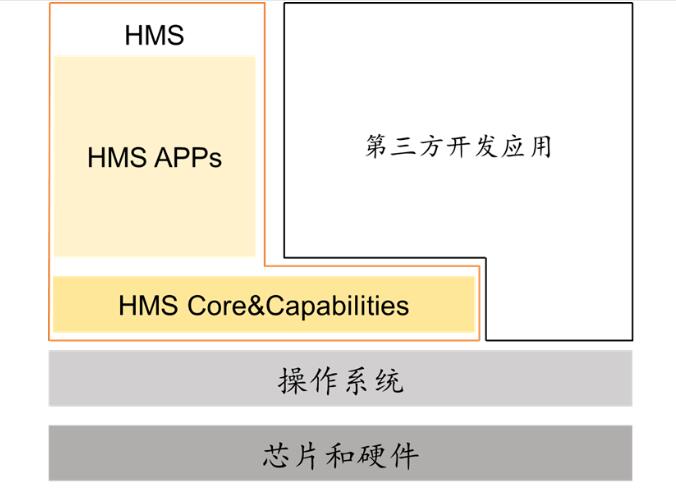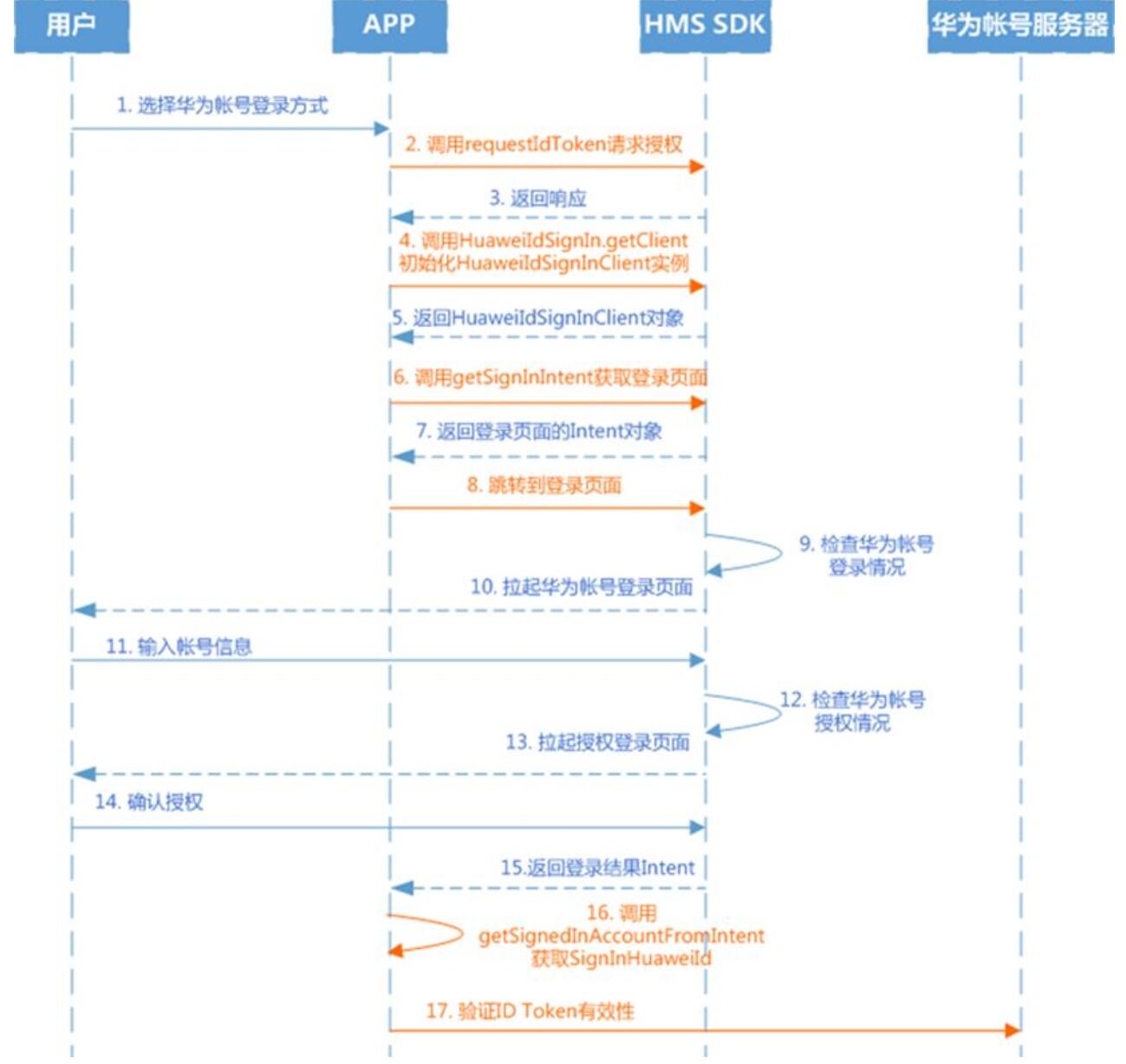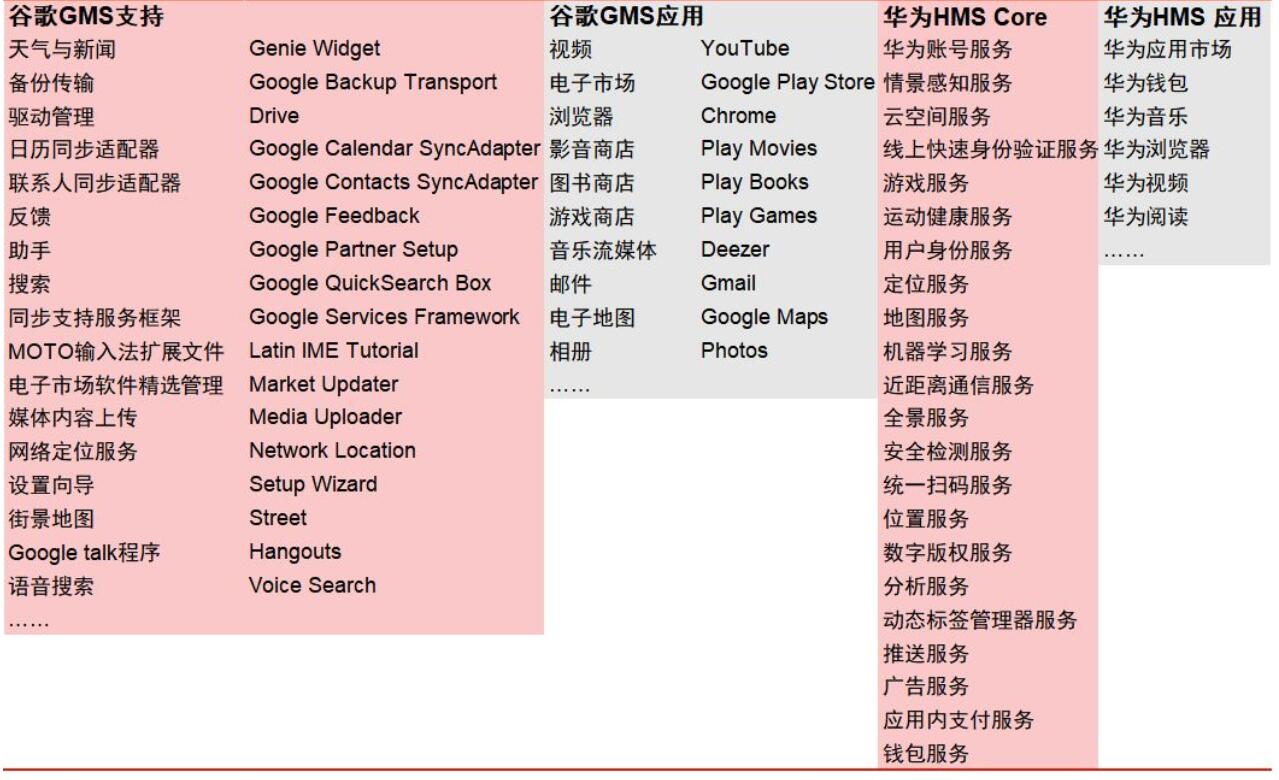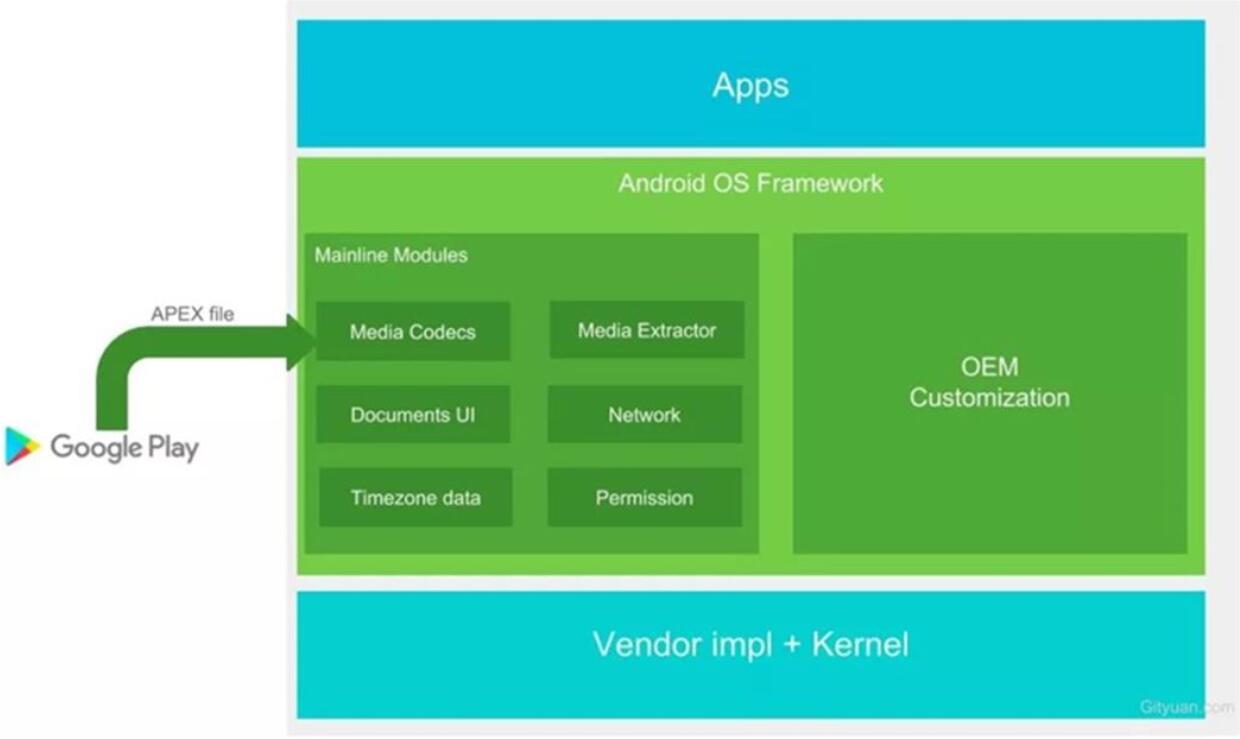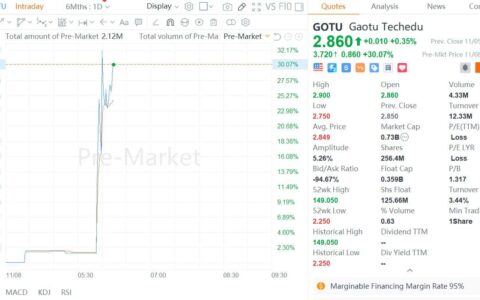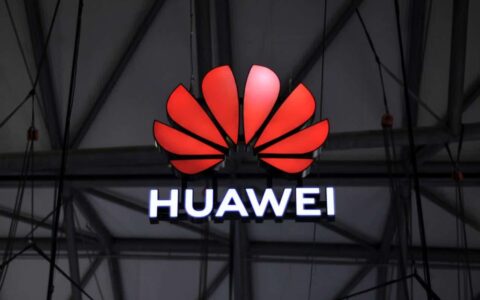HMS (Huawei Mobile Service) is an application ecological solution created by Huawei on mobile devices.
It is based on Huawei's underlying chip (Kirin) and operating system (Harmony OS). Huawei builds the core capabilities of HMS Core to support its own applications.
In addition, Huawei will open the core capabilities of HMS Core to third-party application developers to jointly support Huawei's application ecosystem.
The computer team of Huatai Securities believes that in the face of the US blockade and suppression, Huawei's HMS Core quickly entered the hot horizon and is expected to give birth to China's autonomous mobile application ecosystem.
HMS is Huawei's response to Google's termination of the provision of GMS services to Huawei under the influence of the US Commerce Entity List. Huatai Securities believes that this is perhaps the beginning of China's autonomous mobile application ecosystem.
HMS Core 4.0 is a milestone for Huawei's HMS ecosystem. Because HMS Core 4.0 and Google GMS Core have formed a relatively complete capability benchmarking system in terms of quantity and function, and even individual capabilities have been surpassed.
According to the latest data released by Huawei, the number of developers attracted by the HMS ecosystem has increased from the previous 910,000 to 1.3 million. The App Gallery has more than 400 million monthly active users and 55,000 apps have been launched.
Huatai Securities believes that HMS for Harmony OS is equivalent to GMS for Android:
We found that GMS has the following effects on the improvement of Android technology and market share:
1) Operating system optimization;
2) Create a rich application ecosystem;
3) Brings high stickiness to users.
GMS plus Android operating system has become the most successful mobile operating system. Similarly, HMS is the bridge between Harmony OS and the application ecosystem.
Huatai Securities believes that the ultimate purpose of the launch of HMS is to create an HMS + Harmony OS ecosystem and replace the GMS + Android ecosystem.
The maturity of HMS for Harmony OS includes 1) connecting developers; 2) lowering the developer threshold; and 3) providing core applications.
Huatai Securities said that we must acknowledge that there is still a gap between HMS and GMS. The most important gap is the application ecology and user habits. China-made mobile applications have a long way to go and a bright future.
Huatai Securities believes that 2020 is the starting point of two major technological development trends: 5G Internet of Everything and the rise of China-made underlying IT. These two major technology trends will exist for a long time, and Huawei is a deep participant in these two major technology trends.
HMS and Kunpeng, two Huawei-led ecosystems, lead the formation of China's independent IT ecosystem on the mobile side and the PC / server side, respectively. HMS ecological partners are divided into two categories:
1) the underlying operating system development partner; 2) various mobile application developers.
Kunpeng's computing ecological partners are mainly divided into three categories: 1) product companies, products are complementary to Huawei; 2) service companies, with strong IT service capabilities and customer resources; 3) hardware companies, to supplement Huawei Kunpeng servers Capacity.
The following is the full report of Huatai Securities, translated by cnTechPost:
What is the HMS ecology?
HMS (Huawei Mobile Service) is an application ecological solution created by Huawei on the mobile terminal. Based on the independent underlying chip (Kirin) and operating system (Harmony OS), Huawei builds the core capabilities of the HMS Core to support its own applications.
In addition, Huawei will open the core capabilities of HMS Core to third-party application developers to jointly support Huawei's application ecosystem.
The HMS ecosystem includes a complete set of open HMS Apps and development support HMS Core, HMS Capabilities, HMS Connect, and corresponding IDE tools for development and testing.
HMS Apps
Includes core applications consisting of Huawei Cloud Space, Huawei Smart Assistant, Huawei App Market, Huawei Wallet, Huawei Skyrim, Huawei Video, Huawei Music, Huawei Reading, Huawei Themes and Living Services.
HMS Core
Provide open cloud-side core service capabilities, such as account, payment, push, map, etc.
HMS Capabilities
It integrates Huawei's excellent software and hardware capabilities, such as HiAI, AR engine, and camera capabilities, and opens them to the outside world to meet user needs and enable innovation.
Huawei will make better use of the core-end-cloud collaboration strategy and incorporate the end-side HMS Capabilities at a suitable pace into the HMS Core service capabilities in a planned way to achieve end-side + cloud-side opening.
HMS Connect
It is a series of services for developers and partners for development, testing, listing, operation and so on.
GMS is controlled by others, HMS rises independently
HMS is Huawei's response to Google's termination of the provision of GMS services to Huawei under the influence of the US Commerce Entity List. This is perhaps the beginning of China's autonomous mobile application ecosystem.
To answer whether HMS can support Huawei to eliminate the impact of not using GMS, we must first understand the meaning of GMS.
GMS service affects Huawei's overseas mobile phone market
GMS currently provides services such as Search, Search by Voice, Contact Sync, Calendar Sync, Talk, and Street View, as well as applications such as Google Play store, Gmail, YouTube, Google Maps. ?
GMS has formed a good interaction with its applications. When users use Google services, Google can embed advertisements in various Google services.
For example, when users use Google Maps, they can find ads that search for place name keywords. Ads can also be displayed when using Google Mobile Search.
GMS is not an Android open source project, and it can only be legally installed on Android devices with Google's permission. For the domestic market, mobile phone manufacturers often develop Chinese-based mobile services based on Android, and GMS is not necessary.
But for foreign markets, GMS services are vital to users. According to GMS, Google grants different degrees of authorization to Android phones, and divides mobile phone manufacturers equipped with Android systems into three levels:
1. Free use of Android operating system, but not embedded GMS;
2. Some GMS services are embedded, but the mobile phone cannot be marked with Google's trademark;
3. All GMS services are embedded, and Google trademarks can also be used. If the Google GMS service is built into an Android phone, it is equivalent to a product certified by Google.
Domestic Android phones, including Huawei, currently use the first level of authorization, that is, use the Android operating system, but do not embed GMS services.
However, Huawei's overseas mobile phone sales are embedded with GMS services.
In other words, the Google ban has no effect on the user experience of Huawei mobile phones in China, but overseas users are highly dependent on Google applications. Failure to provide alternative solutions will cause a serious decline in user experience and directly impact Huawei Overseas sales of mobile phones.
Entity List keeps GMS under control
The U.S. Department of Commerce listed Huawei and its 68 subsidiaries on the Entity List on May 15 last year, and then issued three consecutive 90-day "temporary general licenses" on May 20, August 19, and November 18.
On February 13th, a 45-day "Temporary General License" was issued to allow Huawei and its subsidiaries to engage in "specific activities" to ensure the continued operation of the existing related networks in the United States and provide support for existing related mobile services in the United States.
In May 2019, Google responded to the US government's "Entity List" call to ban the provision of GMS services to Huawei phones. On October 13, 2019, Google resumed Huawei's GMS service.
After recovery, Huawei overseas models can continue to be equipped with Google Apps such as Google Play, YouTube, and Gmail.
Although Huawei is included in the Entity List, it has not yet had a substantial impact, because the US Department of Commerce has issued "temporary general licenses" for four consecutive times, and Huawei can still purchase and use goods and services containing US technology.
But this model is not a long-term solution. It is equivalent to a time bomb that resets its time every three months.
As soon as Sino-US trade relations or other conflicts of interest arise, technology cuts will become a bargaining chip.
The first phase of the China-US agreement was signed, but the scientific and technological sanctions could not be ended.
On February 17th, Reuters reported that the United States is considering amending the regulatory requirements to reduce the list of US technologies to 25% from the current 25% to 10%.
If this modification is implemented, it means that TSMC's supply to Huawei will also be limited, and the chip-out process may face a 7nm process outage.
For sustainable development, we must take the road of independent innovation.
The rise of HMS
Faced with the US blockade and suppression, Huawei HMS Core quickly moved to the foreground.
On August 9, 2019, at the Huawei Developer Conference (HDC 2019), Zhang Ping'an, President of Huawei Consumer Business Cloud Services, delivered a keynote speech entitled "Comprehensive Open HMS and Building a Smart New Ecology in All Scenarios", which will be the world's first HMS Ecology, that is, HUAWEI Mobile Services ecosystem.
At the pollen conference on December 21, 2019, Richard Yu, President of Huawei Consumer BG, revealed that Huawei currently has about 4,000-5000 engineers to develop HMS on a large scale, ready to enter the new flagship mobile phone P40 series released by Huawei in 2020 International markets including Europe.
On January 15, 2020, Huawei released HMS Core 4.0 to the world.
HMS Core 4.0 has launched a large number of new features, including Huawei accounts, payment, analysis, cloud space, and game services that have been in operation for many years, advertising and positioning services that have been on the line for 4 months, and a large number of new developers. New capabilities.
These new capabilities include machine learning services, context-aware services, unified code scanning services, short-range communication services, panoramic services, security detection services, dynamic tag manager services, online rapid authentication services, location services, fast application services, digital Copyright services, sports health services, user identity services, etc. Many of these services also support the integration of Huawei core-end-cloud capabilities.
On February 24, 2020, the Honor V30 will be launched in Europe with HMS. The Honor V30 series is Honor's 5G flagship product released at the end of last year and is Honor's first 5G mobile phone.
Honor announced that on February 24, 2020, a global online conference will be held in Europe. Honor V30 will be equipped with HMS service for the first time in Europe. This will also be Huawei's first smartphone with pre-installed HMS ecosystem.
Honor President George Zhao, Honor V30 series and X series will be pre-installed with Huawei App Gallery.
For developers, HMS Core 4.0 has five highlights:
Highlight 1: Global distribution: This set of service open capabilities is distributed to the entire world market. It has achieved coverage of more than 170 countries and regions around the world and provides services to up to 600 million global users.
Highlight two: Cost savings: Start for free and easy to use. From development to listing, up to 3 people can complete several layers of docking for a single KIT service.
Highlight 3: Security and credibility: In compliance with GAPP, GDOR and local regulations, 15 data centers have been deployed in 3 regions around the world, with over 20+ compliance certifications.
Highlight four: Accurate reach: Huawei's application market has over 400 million monthly activities, and it provides 6 data analysis models to help applications build accurate user portraits, as well as multiple push methods based on user behavior to help accurate marketing.
Highlight five: Developer ecology: At present, HMS Core 4.0 has also made significant progress in the construction of key developer ecosystems. Huawei's "Yaoxing Project" provides global developers with a total of one billion US dollars of incentives, attracting a large number of developers Joined around HMS Core 4.0.
Chart: Interaction logic among users, developers, HMS, and Huawei account services
HMS Core 4.0 is a milestone for Huawei's HMS ecosystem. Because HMS Core 4.0 and Google GMS Core have formed a relatively complete capability benchmarking system in terms of quantity and function, and even individual capabilities have been surpassed.
According to the latest data released by Huawei, the number of developers attracted by the HMS ecosystem has increased from the previous 910,000 to 1.3 million. The App Gallery has more than 400 million monthly active users and 55,000 apps have been launched.
Chart: GMS vs. HMS
HMS for Harmony OS is equivalent to GMS for Android
GMS promotes Android development
As the world 's most popular mobile operating system, the development of Android has gone through 17 years. Looking back at the history of Android development, we find that GMS has played a key role in improving Android technology and market share.
Android was established in October 2003 and was acquired by Google in August 2005. The founder Andy Rubin served as the vice president of Google 's engineering department and continued to be responsible for the Android project.
In September 2008, Google officially released the Android 1.0 system. Over the following ten years, the Android version moved forward in the update iteration, and made great improvements in terms of user experience, fluency, battery life, security, privacy, and machine learning.
Chart: Android Development History
HMS has promoted the development of Android operating system in three aspects:
1) Optimization of the operating system
In the first ten years of development, the fragmentation of the Android system has been a pain point. The fragmentation of the Android system poses risks to security and privacy issues, as well as inconsistencies in the experience. However, OTA maintenance and upgrades of older mobile phones are expensive for manufacturers.
Therefore, GMS proposed "Project Mainline" in Android 10.0, which will separate a few modules that have a significant impact on privacy, security, and compatibility into modules, and each module is packaged in APEX format (a new format similar to APK).
It is regularly upgraded by Google through the App Store, so that lower versions of the phone will not get privacy, security and compatibility updates due to fragmentation.
In this way, through the upgrade of the GMS level, the privacy, security and compatibility issues brought about by the fragmentation of the operating system are solved.
Figure 7: GMS optimization for Android fragmentation
2) Create richness of application ecology
GMS opens up basic service packages such as advertising services and location services to developers, helping developers to better acquire customers and monetize, and gradually forms a rich application ecosystem.
3) Core applications bring high stickiness to users
GMS core applications mainly include YouTube, Google Play Store, Google Play Games, Gmail, Google Maps, etc., as well as system data synchronization, backup, contacts, etc. based on Google accounts.
According to App Annie's "2019 Mobile Market Report", Google has 9 of the most popular Internet applications with more than 1 billion monthly active users worldwide. The huge user base of core applications also brings high stickiness of the operating system.
Chart: Internet applications with over 1 billion monthly active users
Relying on the open application ecology and constantly improving operating system performance, the Android operating system has become the most successful operating system on the mobile terminal.
According to IDC data, global Android phones will account for 87% of the market in 2019, and iPhone will only account for 13%.
HMS is the bridge between Harmony OS and the application ecosystem
HMS is an application ecological bridge that matches Harmony OS. Harmony OS and Huawei Developer Conference 2019 are launched, positioning as a full-scenario, distributed, micro-kernel, cross-terminal IoT operating system.
We believe that the ultimate purpose of the launch of HMS is to create an HMS + Harmony OS ecosystem and replace the GMS + Android ecosystem. HMS + Android applied to Honor V30 series in the short term is just a transition solution.
HMS has three effects on the maturity of Harmony OS:
1) Connect developers
At present, Huawei's HMS ecosystem is growing rapidly, with more than 1.3 million registered developers worldwide and more than 55,000 applications connected to HMS Core.
In India, Huawei discussed with the top 150 app developers and provided funding subsidies to invite them to settle in the HMS ecosystem.
In the UK, Huawei also announced a £20 million investment plan to encourage local developers to settle in.
2) Reduce the developer threshold
HMS Core provides Huawei cloud-side core service capabilities to help developers quickly access the HMS ecosystem and build high-quality applications. HMS provides tools for development, growth, and monetization, and directly opens the SDK for developers to use.
Including Huawei account, payment, map, but also machine learning, situational awareness, data monitoring, sports health, analysis services, advertising services, in-app purchases and other services.
3) Provide core applications
HMS Apps include Huawei cloud space, smart assistant, application market, wallet, music, video, theme and other applications, ensuring high-quality user experience in core applications.
HMS needs to cross two hurdles to succeed
We have to admit that there is still a gap between HMS and GMS. The most important gap lies in the application ecology and user habits.
1) Application ecology
According to the "Huawei Application Market's Official Release of the 2018 Annual Security Report", the cumulative downloads of Huawei's application market in 2018 exceeded 240 billion, the highest daily download in 2018 was 830 million, and 270 million monthly active users.
According to App Annie data, 9.8 million apps were released on Google Play in 2018, with a total of nearly 330 billion downloads between 2012 and 2018, total user spending of more than $ 85 billion, and more than 5,000 apps of more than $ 1 million.
From the richness of application ecology, there is still a large gap between Huawei ecology and Google ecology.
2) user habits
The gap in application ecology can be gradually closed through convenient developer tools and developer support plans and catching up with the gap in user habits is a longer process.
This requires more than technical investment and ecological support. Behind it is the struggle for market right to speak, the competition of business and the collision of cultures. China-made mobile application ecology has a long way to go and a bright future.
We believe that 2020 is the starting point of two major technological development trends: 5G Internet of Everything and the rise of China-made underlying IT. These two major technology trends will exist for a long time, and Huawei is a deep participant in these two major technology trends.
5G expands computing scenarios and accelerates industrial development. The development of each generation of communication technology has brought about further expansion of computing boundaries.
From the calculation of a single computer, to the calculation of multiple computers on the Internet, to the supercomputing of computer clusters in the era of cloud computing. The calculated boundaries are gradually extending.
The development of the Internet brought by 3G, the main body of its connection is a computer (single machine). The development of 4G to the mobile Internet is based on human beings.
5G expands the computing boundary, breaks through the limitations of traditional smart terminals such as computers and mobile phones, and evolves to IOT. The main body of its connection is everything.
Compared with 4G, 5G is expected to make the industry change more prominent. The core points of 5G are: high speed, low latency, high capacity (high concurrency). These characteristics are conducive to further expanding the application of computing in a variety of scenarios, including video, Internet of Vehicles, ubiquitous power Internet of Things, industrial Internet and other fields. .
The conditions for the rise of China-made underlying IT have matured. We believe that China currently has the conditions to establish the underlying technology architecture and technical standards for independent IT.
First of all, China has a sufficiently large user market, which can be used to reverse the gradual improvement and maturity of the products from the use of the client. The user base is the soil for IT development. The products of global IT leaders we currently see are also repeated trial and error, debugging and improvement in long-term user use.
In addition, a sound industrial ecology provides enough scenarios. In terms of application scenarios, China is at the forefront of the world. Under different application scenarios and computing scenarios, the demand for related products is different, and it is easy to form a change in the industrial pattern. This is also an opportunity for the development of Chinese IT companies.
Difference between HMS and Kunpeng ecology
HMS and Kunpeng, two Huawei-led ecosystems, lead the formation of China's independent IT ecosystem on the mobile side and the PC / server side, respectively. Huawei's business is divided into four segments: consumer business, enterprise business, operator business, and Cloud & AI.
The leading department of HMS Ecology, the Global Ecological Development Department, is a secondary department affiliated with Consumer BG. The new department president Wang Yankun reports to CBG CEO Richard Yu. The number of staff is tentatively 36.
HMS ecological partners are divided into two categories:
1. The underlying operating system development partner. HMS Core is between the operating system and the application software. The underlying operating system is the catcher of HMS's downward connection.
Zhongke Chuangda has made continuous R & D investment in the field of mobile smart terminal operating systems for many years. Accumulated technologies related to the core terminal's underlying operating system.
In the field of operating systems, the company covers: comprehensive technical advantages at all levels of the operating system, such as application framework, underlying architecture technology, middleware technology, software and hardware integration technology, component certification and graphics and image processing.
2. Various mobile application developers. We believe that companies with 2C mobile application development capabilities are expected to gain development opportunities in the HMS ecosystem, such as mobile office software for Kingsoft Office, multimedia editing software from Wanxing Technology, and mobile reading for Palm Technology.
In addition, Jingming Sheng, CEO of Beiming Software, stated that Beiming Software communicated with Huawei as soon as Harmony OS came out, explored cooperation paths and invested research and development efforts to try to transfer the company's proprietary intellectual property software to Harmony OS platform.
For the computer industry, Kunpeng's computing ecological impact is even greater. Kunpeng's computing ecosystem spans enterprise business BG and the newly established Cloud & AI BG.
Huawei has been able to provide full-stack IT services covering storage, chips, databases, operating systems, servers, data centers, intelligent computing, cloud software, professional services, cloud services, and security.
Kunpeng computing ecological partners are mainly divided into three categories:
1. Product-based companies, whose products are complementary to Huawei. Among the Lingyun plan partners, SuperMap Software, Dongfangtong, Kingsoft Office, UFIDA, and others are familiar product companies in the market. The fields of GIS software, middleware, office software, and ERP are all areas where Huawei does not own or open its own products.
In the shortcomings of its own products, directly establishing partnerships with leading manufacturers in subdivided industries to supplement product capabilities is the key to Huawei's rapid improvement in availability.
2. Service companies with strong IT service capabilities and customer resources. ChinaSoft, ChinaSoft International and other companies are familiar service companies in the market.
Service companies mainly provide large-scale customers with consulting services on IT systems before the cloud, migration during the cloud process, and operation and maintenance after the cloud. Strong service capabilities are the guarantee that customers can successfully complete the cloud.
The trust relationship between customers and service providers is difficult to be replaced in a short time. Establishing cooperation with service providers and integrators can maximize the market potential of Huawei Cloud.
3. Hardware-based company to supplement Huawei Kunpeng server capacity. Outside of Lingyun's plan, we saw that Huawei and Topway Information established Xiangjiang Kunpeng, which is positioned to produce independent brand servers and PCs in the Kunpeng ecosystem.
Donghua Software and Huawei have Pengxiao server production bases in Ningbo, Qingdao and Beijing. We believe that this reflects the openness of Huawei's ecology, and through partners, it has filled its own capacity gap and improved product delivery capabilities.


